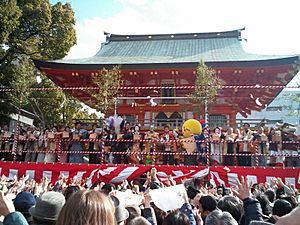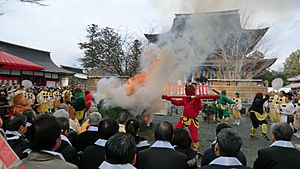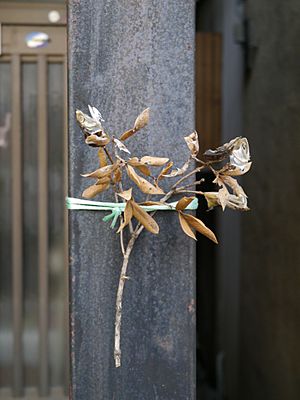Setsubun facts for kids
Quick facts for kids Setsubun |
|
|---|---|

Tokuan shrine
|
|
| Also called | Bean-Throwing Festival, Bean-Throwing Ceremony |
| Observed by | Japanese people |
| Type | religious, cultural |
| Significance | Day before the beginning of spring |
| Date | February 3 |
| Next time | 3 February 2026 |
| Frequency | Annual |
| Related to | Spring Festival (Harumatsuri) |
Setsubun (which means "division of seasons") is a special Japanese festival. It happens just before spring officially begins in Japan. People celebrate it to welcome good luck and drive away bad spirits.
Contents
What is Setsubun?
Setsubun is a traditional event in Japan that celebrates the end of winter. It also marks the start of spring. This festival usually takes place on February 3rd or 4th each year. There are many fun ways people celebrate this day.
Bean-Throwing Ceremony
One of the most famous Setsubun customs is called mame-maki. During this ceremony, people throw roasted soybeans, called mame. As they throw the beans, they shout a special phrase: "Oni wa Soto! Fuku wa Uchi!" This means "Get out, ogre! Come in, happiness!"
After throwing the beans, everyone eats a certain number of them. They eat one bean for each year of their age. This is believed to bring good luck and happiness for the coming year.
Other Setsubun Customs
- Sardine and Holly Charms: Another old custom is to put a sardine head and a holly branch on the door of a house. People believe this helps to scare away Oni, which are like ogres or evil spirits.
- Eating Ehomaki: In the Kansai area of Japan, many people eat a special sushi roll called Ehomaki. This is a long, uncut sushi roll. You must eat it while facing a "lucky direction" for the year. It's also important not to say a word while eating it! Eating it whole is thought to bring good fortune without breaking it.
The History of Setsubun
The word Setsubun literally means "division of the seasons." Long ago, this name was used for the day before each new season began. However, over time, the Setsubun before spring became the most important. This is because it was seen as the start of a new year in the old lunar calendar.
Why Throw Beans?
People believe that both beans and rice have special powers. In ancient times, people used to throw rice to get rid of evil spirits. Later, when Chinese traditions came to Japan, people started throwing beans instead. Since then, throwing beans has been a way to drive away demons on Setsubun.
The Ehomaki Tradition
The custom of eating Ehomaki (a type of makizushi) on Setsubun started in the city of Osaka. It began as a way for merchants to pray for good business. The name Makizushi can also sound like "call over happiness." People eat the roll without cutting it because cutting it might mean "breaking up" good luck.
Ehomaki usually contains seven different ingredients. These ingredients represent the Seven Gods of Fortune. Eating it silently is often done out of respect for these gods.
Setsubun Events Today
Many large shrines and temples in Japan hold special Setsubun events. For example, Narita-san Shinsho-ji in Chiba hosts a big event every year. They invite important people, like celebrities or those born in a lucky Chinese Zodiac year, to perform the mame-maki ceremony. These events attract many people who want to catch some good luck and happiness.
See also
 In Spanish: Setsubun para niños
In Spanish: Setsubun para niños




